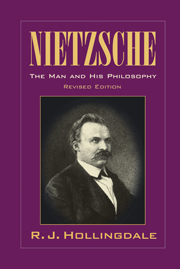Book contents
- Frontmatter
- Contents
- Preface to the Revised Edition
- A List of Nietzsche's Works
- Part I 1844-1869
- Part II 1869-1879
- 4 The Professor
- 5 Wagner, Schopenhauer, Darwin and the Greeks
- 6 Basel and Bayreuth
- 7 Sorrento and an End in Basel
- Part III 1879-1889
- PART IV 1889-1900
- Postscript 1999
- Selective Bibliography
- Index
7 - Sorrento and an End in Basel
from Part II - 1869-1879
Published online by Cambridge University Press: 13 September 2019
- Frontmatter
- Contents
- Preface to the Revised Edition
- A List of Nietzsche's Works
- Part I 1844-1869
- Part II 1869-1879
- 4 The Professor
- 5 Wagner, Schopenhauer, Darwin and the Greeks
- 6 Basel and Bayreuth
- 7 Sorrento and an End in Basel
- Part III 1879-1889
- PART IV 1889-1900
- Postscript 1999
- Selective Bibliography
- Index
Summary
… it was during the years of my lowest vitality that I ceased to be a pessimist: the instinct for self-recovery forbade to me a philosophy of indigence and discouragement. (EH-I 2)
The breach with Wagner was by the autumn of 1876 virtually an accomplished fact. Nietzsche met him only once more: at Sorrento in November of that year. It was a chance meeting. When Nietzsche left Bayreuth on the 27th August he did so in the company of Paul Rée, with whom he had established a close friendship. (As Rée was a Jew this friendship was held against him at Wahnfried.) The state of his health made it obvious he would be unable to go straight back to work; he asked for sick leave and on the 15th October was released from all duties for a year. In anticipation of this he had left with Rée on the 1st for the small spa of Bex, in Canton Waadt, where they stayed until the 20th: his health had by then settled into the rhythmic cycle of sickness and recovery which was to persist for the remainder of his life. Towards the end of their stay in Bex they were joined by the young novelist Albert Brenner, and the three went off on the 20th to Genoa and thence by boat to Naples; there they were met by Malwida, who took them to a villa she had rented outside Sorrento—the Villa Rubinacci—where they stayed until the following spring.
Malwida's account of her adventurous life can be read in her Memoirs of an Idealist. By the time Nietzsche met her at Bayreuth in 1872 she had become a kind of universal aunt to the younger generation of writers and artists of the German-speaking world: she had an enormous circle of acquaintances most of whom were people she had helped in one way or another, and it was quite in character that she should have offered the three young men a place to work and relax during the winter months. The villa stood on the coast a fifteenminute walk from Sorrento with a view over the open sea to Naples and Vesuvius. ‘We live … in the quarter in which there are only gardens and villas and garden-houses,’ Brenner wrote to his family.
- Type
- Chapter
- Information
- NietzscheThe Man and His Philosophy Revised Edition, pp. 107 - 112Publisher: Cambridge University PressPrint publication year: 1999



